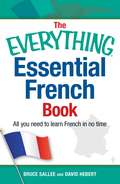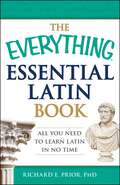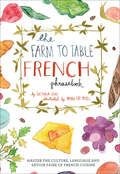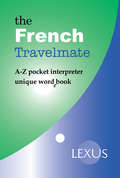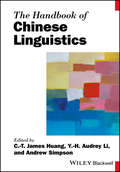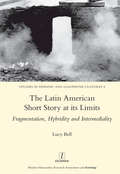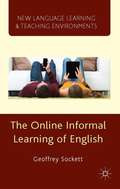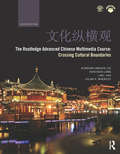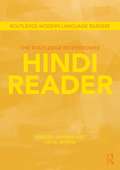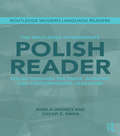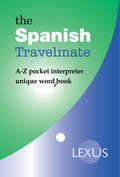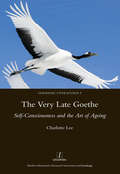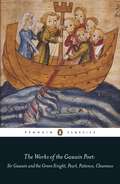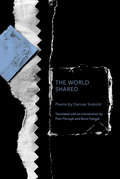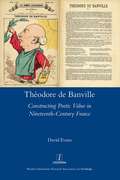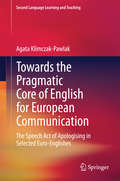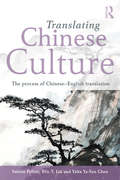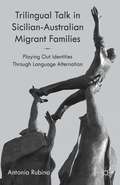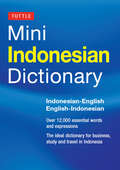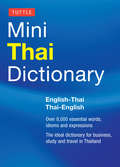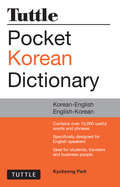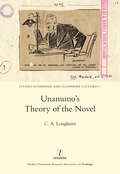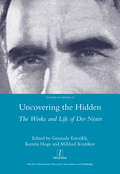- Table View
- List View
The Everything Essential French Book: All You Need to Learn French in No Time (Everything® Series)
by Bruce Sallee David HebertAll the basics of French--fast and easy!Whether you are planning a vacation, adding a valuable second language to your resume, or simply brushing up on your skills, The Everything Essential French Book is your perfect introduction to the French language. With easy-to-follow instructions and simple explanations, this portable guide covers the most important basics, including:The French alphabet, accents, and translation.Common French phrases and greetings.Everyday questions and answers.Verb tenses and sentence structure.How to place an order and give commands.The Everything Essential French Book has all you need to get from bonjour to au revoir in no time!
The Everything Essential Latin Book
by Richard E. PriorThe basics of Latin made fun--and fast! Learning the basics of Latin can vastly improve your vocabulary and even provide keys to understanding legal, medical, and scientific terminology. The Everything Essential Latin Book is your perfect introduction to this fascinating language. With easy-to-follow instructions and simple explanations, this portable guide covers the most important basics of Latin, including: The Roman alphabet and translation The all-important syntax of Latin Getting someone's attention and giving commands Common questions and answers Describing people and places Verb tenses Grammatical voice With The Everything Essential Latin Book, you'll be speaking like an ancient Roman in no time!
The Everything Essential Latin Book: All You Need to Learn Latin in No Time
by Richard E PriorThe basics of Latin made fun--and fast!Learning the basics of Latin can vastly improve your vocabulary and even provide keys to understanding legal, medical, and scientific terminology. The Everything Essential Latin Book is your perfect introduction to this fascinating language. With easy-to-follow instructions and simple explanations, this portable guide covers the most important basics of Latin, including:The Roman alphabet and translationThe all-important syntax of LatinGetting someone's attention and giving commandsCommon questions and answersDescribing people and placesVerb tensesGrammatical voiceWith The Everything Essential Latin Book, you'll be speaking like an ancient Roman in no time!
The Farm to Table French Phrasebook: Master the Culture, Language and Savoir Faire of French Cuisine
by Victoria MasFrench culinary phrases, foodie terms, and cultural tips come together in the ultimate food-lover&’s guide pays des délices. Everyone can tell the difference between Brie and Caembert, but few know their Valençay from Pélardon. Luckily, The Farm to Table French Phrasebook serves up the vital French expressions other guides leave off the plate. From the specialty vocabulary of chefs in gourmet restaurants to slang terms rarely heard outside a country market, here&’s everything the reader needs for a gourmet tour of France (or the local bistro!). A comprehensive language guide for food lovers, this indispensable companion also offers a fascinating history of French eats, complete with delicious facts about the cuisines of every region from Alsace&’s pinot gris to Normandy&’s Pot-au-feu. This beautifully illustrated book is perfect to take along for a day of sampling gourmet local specialties, or it makes a great present for the Francophile in your life.The Farm to Table French Phrasebook opens a bountiful world of food that you won&’t find in any textbook or classroom:• Navigate produce markets, charcuteries and patisseries• Prepare meals the French way with delicious, authentic recipes• Speak the lingo of Paris&’s top restaurants and bistros• Pair regional wines with delightful cheeses• Master the proper table etiquette for dining at a friend&’s house
The French Travelmate
by Lexus Sandrine FrançoisThe French Travelmate phrasebook and dictionary gives you a detailed yet easy-to-use A to Z list of English words and phrases with French translations for quick-find reference. There are more than 3500 words and phrases, and the French translations come together with an easy-to-read pronunciation guide. Tap a hyperlink (there are hundreds of them) to go to special sections: travel tips about being in France; basic language notes; typical French replies to your French questions; conversion tables. These are features which make the Travelmate the must-have ebook French phrasebook download for the traveller who wants to really communicate. The French Travelmate phrasebook and dictionary also gives you a detailed French menu reader of over 500 items and a dictionary section with translations of over 300 common French signs and notices. This is the little book that's a big help. And a joined-up language experience.
The Handbook of Chinese Linguistics (Blackwell Handbooks in Linguistics)
by Andrew Simpson C.-T. James Huang Y.-H. Audrey LiThe Handbook of Chinese Linguistics is the first comprehensive introduction to Chinese linguistics from the perspective of modern theoretical and formal linguistics. Containing twenty-five chapters, the book offers a balanced, accessible and thoughtfully organized introduction to some of the most important results of research into Chinese linguistics carried out by theoretical linguists during the last thirty years. Presenting critical overviews of a wide range of major topics, it is the first to meet the great demand for an overview volume on core areas of Chinese linguistics.Authoritative contributions describe and assess the major achievements and controversies of research undertaken in each area, and provide bibliographies for further reading. The contributors refer both to their own work in relevant fields, and objectively present a range of competitor theories and analyses, resulting in a volume that is fully comprehensive in its coverage of theoretical research into Chinese linguistics in recent years. This unique Handbook is suitable both as a primary reader for structured, taught courses on Chinese linguistics at university level, and for individual study by graduates and other professional linguists.
The Latin American Short Story at its Limits: Fragmentation, Hybridity and Intermediality
by Lucy BellThe Latin American short story has often been viewed in terms of its relation to orality, tradition and myth. But this desire to celebrate the difference of Latin American culture unwittingly contributes to its exoticization, failing to do justice to its richness, complexity and contemporaneity. By re-reading and re-viewing the short stories of Juan Rulfo, Julio Cortazar and Augusto Monterroso, Bell reveals the hybridity of this genre. It is at once rooted in traditional narrative and fragmented by modern experience; its residual qualities are revived through emergent forms. Crucially, its oral and mythical characteristics are compounded with the formal traits of modern, emerging media: photography, cinema, telephony, journalism, and cartoon art.
The Native Languages of South America
by Loretta O'Connor Pieter MuyskenIn South America indigenous languages are extremely diverse. There are over one hundred language families in this region alone. Contributors from around the world explore the history and structure of these languages, combining insights from archaeology and genetics with innovative linguistic analysis. The book aims to uncover regional patterns and potential deeper genealogical relations between the languages. Based on a large-scale database of features from sixty languages, the book analyses major language families such as Tupian and Arawakan, as well as the Quechua/Aymara complex in the Andes, the Isthmo-Colombian region and the Andean foothills. It explores the effects of historical change in different grammatical systems and fills gaps in the World Atlas of Language Structures (WALS) database, where South American languages are underrepresented. An important resource for students and researchers interested in linguistics, anthropology and language evolution.
The Online Informal Learning of English
by Geoffrey SockettYoung people around the world are increasingly able to access English language media online for leisure purposes and interact with other users of English. This book examines the extent of these phenomena, their effect on language acquisition and their implications for the teaching of English in the 21st century.
The Routledge Advanced Chinese Multimedia Course: Crossing Cultural Boundaries
by Carolyn Lee Hsin-Hsin Liang Liwei Jiao Julian WheatleyThe Routledge Advanced Chinese Multimedia Course: Crossing Cultural Boundaries is an innovative multimedia course for advanced students of Chinese. Written by a team of highly experienced instructors, the book offers advanced learners the opportunity to consolidate their knowledge of Chinese through a wide range of activities designed to build up both excellent language skills and cultural literacy.? Divided into four thematic units covering popular culture, social change, cultural traditions, and politics and history, with each unit presenting three individual lessons, the volume provides students with a structured course which efficiently supports the transition from an intermediate to an advanced level. The many different texts featured throughout the lessons present interesting and accurate information about contemporary China and introduce students to useful vocabulary, speech patterns, and idiosyncratic language usage. Key features include Lively and detailed discussions of grammatical points and sentence patterns Engaging exercises for developing grammatical concepts and insight into the character writing system Systematic review of earlier material to ensure consolidation of learning Coverage of diverse and culturally relevant topics such as online dating, changing views of marriage, food culture, Confucianism? and democracy in China. Extensive cultural and historical notes providing background to the subjects presented Complementary CDs to enhance listening skills. Free companion website (http://duke.edu/web/chinesesoc/) offering a wealth of video content forming the basis of many of the listening activities linked to topics within the book. Extensively revised and updated throughout, this new edition includes new material and activities on synonyms and substantial improvements to the "composition", "Focus on characters" and "Language practicum" sections. The improved Instructor’s Resource Manual, which includes activity tips, additional exercises, answer keys and the traditional character texts, is available at http://www.routledge.com/books/details/9780415841337/
The Routledge Intermediate Hindi Reader
by Tej K. Bhatia Naresh SharmaThe Routledge Intermediate Hindi Reader has been specially designed for intermediate and advanced learners of Hindi and comprises a broad selection of graded readings. The materials have been carefully selected to ensure that students receive exposure to a wide variety of authentic Hindi texts, including news and magazine articles, extracts from social media websites, film dialogues and contemporary Hindi literature. Each reading is fully supported by: pre-reading activities notes on cultural references in the text a vocabulary list with English translation notes on key grammatical points arising from the text text-related comprehension questions and vocabulary-based exercises suggestions for writing and discussion activities based on the text a key to comprehension questions and vocabulary-based exercises online support which includes audio recordings and translations of texts, available at http://www.routledge.com/books/details/9780415601764/ Suitable for both class use and independent study, The Routledge Intermediate Hindi Reader is an essential tool for increasing language proficiency and enriching learners’ cultural knowledge.
The Routledge Intermediate Polish Reader: Polish through the press, internet and contemporary literature
by Aniela Grundy Oscar SwanThe Routledge Intermediate Polish Reader is designed for intermediate students of Polish and includes a wide range of graded texts. The readings are taken from an assortment of contemporary Polish writing, including extracts from modern literature and articles from magazines and newspapers. The texts have been specifically selected to ensure that students receive maximum exposure to topics relevant to Polish language, history, culture and society, making this Reader an engaging and stimulating resource with a meaningful cultural context. Each reading is fully supported by: a general introduction text-related comprehension questions and extensive vocabulary exercises explanations of any difficult grammar structures encountered in the text a comprehensive glossary at the back of the book detailed cultural-historical notes answer key grammar supplement Suitable for both class use and independent study, The Routledge Intermediate Polish Reader is an essential tool for vocabulary learning and increasing reading proficiency.
The Spanish Travelmate
by Lexus Alicia de Benito Harland Mike HarlandThe Spanish Travelmate phrasebook and dictionary gives you a detailed yet easy-to-use A to Z list of English words and phrases with Spanish translations for quick-find reference. There are more than 3500 words and phrases, and the Spanish translations come together with an easy-to-read pronunciation guide. Tap a hyperlink (there are hundreds of them) to go to special sections: travel tips about being in Spain; basic language notes; typical Spanish replies to your Spanish questions; conversion tables. These are features which make the Travelmate the must-have ebook Spanish phrasebook download for the traveller who wants to really communicate. The Spanish Travelmate phrasebook and dictionary also gives you a detailed Spanish menu reader of over 500 items and a dictionary section with translations of over 300 common Spanish signs and notices. This is the little book that's a big help. And a joined-up language experience.
The Very Late Goethe: Self-Consciousness and the Art of Ageing
by Charlotte LeeGoethe's career was an unusually long and productive one: he became a literary celebrity in the 1770s and remained so until his death in 1832. The distinguishing feature of his last works is their self-consciousness, their preoccupation both with the business of writing and with personal development. In the first cross-genre study of this period of Goethe's work, Charlotte Lee traces the theme in his last major poems and autobiographical writings, before turning to the two 'giants', 'Wilhelm Meisters Wanderjahre' and 'Faust II'. All these works share a tendency to allude subtly to earlier moments from Goethe's own literary output, but to fashion them into writing which is quite new - even though (or perhaps because) he himself is old. This book seeks to understand the unique perspective of one nearing the end of a long life.
The Works of the Gawain Poet: Sir Gawain and the Green Knight, Pearl, Cleanness, Patience
by Ad Putter Myra StokesA new volume of the works of the Gawain poet, destined to become the definitive edition for students and scholars.This volume brings together four works of the unknown fourteenth-century poet famous for the Arthurian romance Sir Gawain and the Green Knight, in their original Middle English. In one of the great tales of medieval literature, Gawain, the noblest knight of King Arthur's court, must keep a deadly bargain with a monstrous knight and resist the advances of his host's beautiful wife. The dream vision of Pearl depicts a bereaved father whose lost child leads him to glimpse heaven. And in moral poems based on stories from the Bible, Cleanness warns against sins of the flesh and of desecration, while Patience encourages readers to endure suffering as God's will.Little is known about the so-called 'Gawain poet', who wrote during the late fourteenth century. It is believed that he came from south-east Cheshire, an important cultural and economic centre at the time, and he was clearly well-read in Latin, French and English. Although he is not named as the author of Sir Gawain and the Green Knight, Pearl, Patience, Cleanness, the four works have been attributed to him based on a careful comparison of their language, date and themes.Myra Stokes was formerly Senior Lecturer in the Department of English at Bristol University. Her books include Justice and Mercy in Piers Plowman and The Language of Jane Austen.Ad Putter teaches at the English Department and the Centre for Medieval Studies of the University of Bristol, where is Professor of Medieval English Literature. His monographs include Sir Gawain and the Green Knight and French Arthurian Romance and An Introduction to the Gawain Poet, and he is also co-editor of The Cambridge Companion to the Arthurian Legend.
The World Shared (Lannan Translations Selection Series)
by Dariusz SosnickiDariusz Sosnicki's poems open our eyes to the sublime just beneath the surface of the mundane: a train carrying children away from their parents for summer vacation turns into a ravenous monster; a meal at a Chinese restaurant inspires a surreal journey through the zodiac; a malfunctioning printer is a reminder of the ghosts that haunt us no matter where we find ourselves.Among the perpetrators and victims,buzzed or wasted to the bone,gliding without their blinkers onin the ruts of the national fate—they're not at home.Dariusz Sosnicki is an award-winning poet, essayist, and editor in Poland.
Theodore De Banville: Constructing Poetic Value in Nineteenth-century France
by David EvansTheodore de Banville (1823-1891) was a prolific poet, dramatist, critic and prose fiction writer whose significant contribution to poetic and aesthetic debates in nineteenth-century France has long been overlooked. Despite his profound influence on major writers such as Baudelaire, Rimbaud, Verlaine and Mallarme, Banville polarised critical opinion throughout his fifty-year career. While supporters championed him as a virtuoso of French verse, many critics dismissed his formal pyrotechnics, effervescent rhythms and extravagant rhymes as mere clowning. This book explores how Banville's remarkably coherent body of verse theory and practice, full of provocative energy and mischievous humour, shaped debates about poetic value and how to identify it during a period of aesthetic uncertainty caused by diverse social, economic, political and artistic factors. It features a detailed new reading of Banville's most infamous and misunderstood text, the Petit Traitede poesie francaise, as well as extended analyses of verse collections such as Les Stalactites, Odes funambulesques, Les Exiles, Trente-six Ballades and Rondels, illuminated by wide reference to Banville's plays, fiction and journalism. Evans elucidates not only aesthetic tensions at the heart of nineteenth-century French verse, but also a centuries-old tension between verse mechanisms and an unquantifiable, mysterious and elusive poeticity which emerges as one of the defining narratives of poetic value from the Middle Ages, via the Grands Rhetoriqueurs and Dada, to the experiments of the OuLiPo and beyond.
Towards the Pragmatic Core of English for European Communication
by Agata Klimczak-PawlakEnglish in Europe is not one but many, and substantial differences in the way people from different countries communicate using it may cause misunderstandings. This book shows that, through research into the pragmatic behaviour of non-native speakers of English from across Europe, it is possible to uncover the core-the shared strategies. This common pragmatic linguistic behaviour is proposed as the basis for a reference guide for those who wish to successfully communicate in English in Europe. The study reported on in this book is based on the analysis of the speech act of apologizing as realized by 466 respondents from 8 European countries, all proficient users of English involved in teacher-training programmes. The results Provide a basis for practical teaching and in-class research.
Translating Chinese Culture: The process of Chinese--English translation
by Valerie Pellatt Eric T. Liu Yalta Ya-Yun ChenTranslating Chinese Culture is an innovative and comprehensive coursebook which addresses the issue of translating concepts of culture. Based on the framework of schema building, the course offers helpful guidance on how to get inside the mind of the Chinese author, how to understand what he or she is telling the Chinese-speaking audience, and how to convey this to an English speaking audience. A wide range of authentic texts relating to different aspects of Chinese culture and aesthetics are presented throughout, followed by close reading discussions of how these practices are executed and how the aesthetics are perceived among Chinese artists, writers and readers. Also taken into consideration are the mode, audience and destination of the texts. Ideas are applied from linguistics and translation studies and each discussion is reinforced with a wide variety of practical and engaging exercises. Thought-provoking yet highly accessible, Translating Chinese Culture will be essential reading for advanced undergraduates and postgraduate students of Translation and Chinese Studies. It will also appeal to a wide range of language studies and tutors through its stimulating discussion of the principles and purposes of translation.
Trilingual Talk in Sicilian-Australian Migrant Families
by Antonia RubinoThis book explores the linguistic and cultural identities of Sicilians in Australia, through conversations gathered within the family, survey data and interviews. The study is placed in the context of the family migrant experience and the shifting attitudes towards immigrant languages in Australia.
Tuttle Mini Indonesian Dictionary: Indonesian-English / English-Indonesian
by Katherine DavidsenThis is a completely up-to-date Indonesian mini dictionary.Tuttle Mini Indonesian Dictionary is ideal for any application where a handy and portable dictionary is required. <P><P> Intended for use by tourists, students, and business people traveling to Indonesia or as an Indonesian language study reference Mini Indonesian Dictionary is an essential tool for communicating in Indonesian. It's useful pocket-sized format and easy-to read type will make translating Indonesian much easier. In addition to being an excellent English to Indonesian dictionary and Indonesian to English dictionary Mini Indonesian Dictionary contains important notes on the Indonesian language, Indonesian grammar and Indonesian pronunciation. All Indonesian words are written in English as well as Indonesian script so that in the case of difficulties the book can simply be shown to the person the user is trying to communicate with.This mini dictionary contains the following essential features: Bidirectional Indonesian-English and English-Indonesian. Over 12,000 essential Indonesian words, as well as useful Indonesian expressions and idioms. Headwords printed in blue for quick and easy reference. A basic overview of Indonesian grammar and pronunciation. All the latest Indonesian social media and computer terms.
Tuttle Mini Thai Dictionary: Thai-English / English-Thai
by Scot Barmé Pensi NajaithongThis is a completely up-to-date Thai mini dictionary.Tuttle Mini Thai Dictionary is ideal for any application where a handy and portable dictionary is required. <P><P> Intended for use by tourists, students, and business people traveling to Thailand or as a language study reference to learn Thai, Mini Thai Dictionary is an essential tool for speaking Thai. It's useful pocket-sized format and easy-to read type will make translating Thai much easier. In addition to being an excellent English to Thai dictionary and Thai to English dictionary this mini dictionary contains important notes on the Thai language, Thai grammar and Thai pronunciation. All Thai words are written in English as well as Thai script so that in the case of difficulties the book can simply be shown to the person the user is trying to communicate with.This mini dictionary contains the following essential features: Bidirectional Thai to English and English to Thai. Over 5,000 entries in each direction. Useful Thai expressions and idioms. Headwords printed in blue for quick and easy reference. A basic overview of Thai grammar and pronunciation. All the latest Thai social media and computer terms .
Tuttle Pocket Korean Dictionary: Korean-English English-Korean
by Kyubyong ParkIt's never a good idea to be overly-relient on technology while traveling! Look up words quickly and easily with this great Korean dictionary.<P><P>Intended for use by tourists, students, and business people travelling to Korea Tuttle Pocket Korean Dictionary is an essential tool for communicating in Korean. It features all the essential Korean vocabulary appropriate for beginning to intermediate students. It's handy pocket format and user-friendly, two color layout will make any future trip to Korea much easier. All entries are written in a Romanized form as well as Korean script (hangul) so that in the case of difficulties the book can simply be shown to the person the user is trying to communicate with.This dictionary includes the following key features: Over 18,000 words and expressions in the Korean language. Korea-English and English-Korean sectionsFully updated with recent vocabulary and commonly used South Korean slang. Clear, user friendly layout with headwords in blue. Romanized and Korean Script (hangul) for every entry.Other books from this bestselling series you might enjoy include: Pocket Japanese Dictionary, Pocket Mandarin Chinese Dictionary, and Pocket Cantonese Dictionary.
Unamuno's Theory of the Novel
by C.A. LonghurstMiguel de Unamuno (1864-1936) is widely regarded as Spain's greatest and most controversial writer of the first half of the twentieth century. Professor of Greek, and later Rector, at the University of Salamanca, and a figure with a noted public profile in his day, he wrote a large number of philosophical, political and philological essays, as well as poems, plays and short stories, but it is his highly idiosyncratic novels, for which he coined the word nivola, that have attracted the greatest critical attention. Niebla (Mist, 1914) has become one of the most studied works of Spanish literature, such is the enduring fascination which it has provoked. In this study, C. A. Longhurst, a distinguished Unamuno scholar, sets out to show that behind Unamuno's fictional experiments there lies a coherent and quasi-philosophical concept of the novelesque genre and indeed of writing itself. Ideas about freedom, identity, finality, mutuality and community are closely intertwined with ideas on writing and reading and give rise to a new and highly personal way of conceiving fiction.
Uncovering the Hidden: The Works and Life of Der Nister
by Gennady EstraikhDer Nister (Pinkhes Kahanovitsh, 1884-1950) is widely regarded as the most enigmatic author in modern Yiddish literature. His pseudonym, which translates as 'The Hidden One', is as puzzling as his diverse body of works, which range from mystical symbolist poetry and dark expressionist tales to realist historical epic. Although part of the Kiev Group of Yiddish writers, which also included David Bergelson and Peretz Markish, Der Nister remained at the margins of the Yiddish literary world throughout his life, mainstream success eluding him both in- and outside the Soviet Union. Yet, to judge from the quantity of recent research and translation work, der Nister is today one of the best remembered Yiddish modernists. The present collection of twelve original articles by international scholars re-examines Der Nister's cultural and literary legacy, bringing to light new aspects of his life and creative output.
